|
|
Humble Origins of the Union at Dupuis Frères
by Sylvie
Marier
The Dupuis Frères department store was a
commercial
success for over 50 years. Its popular catalogue, published in French,
helped
the store gain an edge over its competition by wooing the French-Canadian
market,
which was virtually untapped at the time. An advocate of ideologies such
as nationalism,
Catholicism, and paternalism, the company promoted traditional Quebec
values.
The story of Dupuis Frères is that of a successful family business
and
the first national Catholic union to represent store employees.
A Religious Influence | Essential
Characteristics of the Catholic Confederation | Leaders
of
the Union | Company Paternalism | Management
Supports the Union | Union Demands and the Status of
Women
| Repercussions of the Second World War | Conclusion
| Further Reading
A Religious Influence
|
The management of Dupuis Frères played a major role in the
founding
of the Syndicat catholique et national des employés de magasin
(Dupuis
Frères Branch) in 1919. The union's members were the
employees of
the store and the postal outlet. In the 1930s, almost 900 of the
company's
employees were unionized; the others joined shortly thereafter.
|
| |
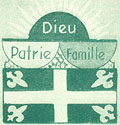 |
|
| |
 The
three ideological pillars of the Dupuis Frères branch of the union:
God,
Family, and Country. Le Duprex 10 (12): 273. The
three ideological pillars of the Dupuis Frères branch of the union:
God,
Family, and Country. Le Duprex 10 (12): 273.
|
|
| |
|
|
|
|
| |
 |
|
| |
 Postal
outlet workers, October 1948. Postal
outlet workers, October 1948.
|
|
| |
|
|
|
|
|
This was a source of pride for management. When the union became
affiliated
with the Confédération des travailleurs catholiques du
Canada (CTCC)
in 1922, employees had to be Catholic to join. They were also expected to
be
sober and orderly and to refrain from joining associations that were
considered
"neutral", that is, associations that were not Catholic. In
the union's
early years, employees filled out a membership application that later
became
a membership certificate. In 1950, Thérèse Fyfe, the
assistant
treasurer, sought to simplify the membership process and requested that
the union
simply issue union cards.
|
| |
 |
|
Among the French Canadian
population and religious communities, Dupuis Frères was seen as a
company
that protected its workers. This advertisement, published in Le
Travail in
1939, helped the company maintain that image.
|
 |
|
|
| |
 |
|
Delegates from the Dupuis
Frères union attended the annual CTCC convention. Founded in 1922,
the
CTCC was an interprofessional labour organization that represented various
Canadian labour groups. With time, it lost its religious characteristics.
In 1960, it became a secular union and was renamed
Confédération des
syndicats nationaux (CSN). Le Duprex 5(1): 8.
|
 |
|
|
| |
 |
|
The first version of the
union
membership application form, 1925. As the union's constitution was not
very complex, its main clauses were included on the form. That is no
longer the case.
|
 |
|
|
|
|
| |
 |
|
A saleswoman's membership
certificate, 1934. A few years later, the form was revised and replaced
by a membership card. Le Duprex 3(1928): cover.
|
 |
|
|
|
The union's emblem features the three values upon which the
organization
was founded: nationalism, Catholicism and paternalism. These values were
shared
by the company and clearly illustrate the influence of the Church, which
played
a determining role in the evolution of the union and its ideology. The
Church
became involved in the labour movement in an attempt to curb the
increasing popularity
of secular unions, which were called "neutral." It feared that
such
unions - established mainly in non-Catholic areas - might
threaten
the moral beliefs of Catholic workers.
|
| |
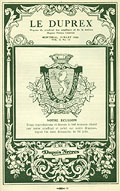 |
|
| |
 The
union's emblem was created in 1928 and blessed by the chaplain during
the Saint-Jean-Baptiste parade. Le Duprex 2(10): 10. The
union's emblem was created in 1928 and blessed by the chaplain during
the Saint-Jean-Baptiste parade. Le Duprex 2(10): 10.
|
|
| |
|
|
|
|
Essential Characteristics of the Catholic
Confederation
| |
 |
|
J.-A. Clément was
the
union's
chaplain from 1940 to 1952. The chaplain participated in important union
decisions and made sure they were consistent with Church doctrine. He
attended union executive meetings and could be called upon to provide
an opinion on urgent matters. Le Duprex, 11(1): 5.
|
 |
|
The Dupuis union had to adopt the four essential characteristics of the
Catholic
confederation with which it was affiliated. It was required to include the
word
"Catholic" in its name (Syndicat catholique et national des
employés
de magasin (Dupuis Frères Branch)), have a chaplain present at
union meetings,
accept only Catholic members, and comply with the social doctrine of the
Catholic
Church. All important decisions had to be in accordance with the tenets of
the
Church, which were the ideological foundation of the union. Justice,
charity,
and obedience to those in authority were the three underlying principles
of the
Church's doctrine. The union encouraged a spirit of collaboration
and harmony
between the employees and their employer. Strikes were, therefore, out of
the
question because they challenged the established order. This purist social
doctrine
imposed a way of thinking on the union that did not serve the interests of
the
workers.
The chaplain was responsible for ensuring that the Church's
doctrine
was religiously adhered to. From the founding of the union until the
strike in
1952, at least three priests occupied the chaplain position: Edmour
Hébert
(1919-1926), Théobald Paquette (1926-1940), and J.-A.
Clément
(1940-1952).
In 1919, in a speech delivered to the members of the fledgling union,
Hébert
stated that "[T]he purpose of a Catholic union was to work towards
cordial
relations between employees and their employers, and to do so in a way
that was
just." [transl.] The Church wanted to avoid power struggles between
the
two groups of divergent interests. It tried to justify the inevitable
social
hierarchy that existed by accepting it. It was in this spirit that the
employee
monthly, Le Duprex, was created in 1926. The publication was to
be "the
place where the various parts of the large Dupuis organization would be
united
into a homogeneous whole." [transl.]
| |
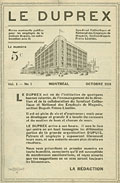 |
|
Cover of the first issue of
Le
Duprex, the Dupuis Frères employee monthly. It served as a
propaganda
tool aimed at religious communities, since it always highlighted Christian
values.Le Duprex 1(1): cover.
|
 |
|
|
Leaders of the Union
The responsibilities of the union leaders (called
"officers"),
as well as the number of members on the executive, remained more or less
the
same over the years. However, the chaplain and the "visitor"
did
see their duties change with the times. At first, the chaplain played a
key role
on the executive, but he gradually lost his influence and his position was
abolished
in the 1960s as a result of the declericalization of Quebec society.
|
Officer
|
Duties
|
|
President
|
- Chairs union meetings and leads the discussions, but cannot intervene
or
participate in the discussions.
- Represents the union at official functions.
- Calls meetings.
- Monitors the application of regulations.
- Signs cheques, together with the treasurer and the proctor
|
|
Vice-president
|
- Replaces the president, if necessary.
|
|
Secretary
|
- Writes and reads meeting minutes, records them in a register, and
signs
them at meetings, together with the president.
- Gives union members access to the minute registers.
- Files and keeps all correspondence.
- Reads all documents that need to be brought to the attention of
meeting
participants.
|
|
Treasurer
|
- Looks after the accounting.
- Collects dues and issues receipts.
- At monthly meetings, reports on the amounts collected.
- Endorses cheques with the union seal.
- Makes all authorized disbursements.
- Produces the bankbooks at each meeting.
- Pays illness and death benefits.
|
|
Proctor
|
- Checks member applications and benefits paid.
- Signs cheques, together with the president and the treasurer.
|
|
Auditor
|
- Checks the books.
- At each meeting, asks the treasurer for the bankbooks and checks
their state.
- Checks inventories and accounts and comments on them at the
meetings.
|
|
Commissaire ordonnateur
|
- Organizes meetings.
- Rents meeting space and accessories.
- Checks if all members are in good standing.
- Organizes the company party and other events.
- Checks candidates' background, habits and morals, as well as
members'
conduct and compliance with the regulations.
|
Source: Le Duprex 12 (8): 317-318. (transl.)
Archives-HEC Montréal, Dupuis Frères Limitée fonds,
P049
The position of "visitor" was established in the 1920s and
disappeared
after the Second World War. The duties of the position within the union
executive
were never clearly defined and its name indicates that it was marginal in
nature
because it referred to someone who was not really a member of the
executive,
but rather met with its members. Occupied mainly by women, this position
had
no effective influence on the executive, since it probably was not
essential
to the proper functioning of the organization.
Company Paternalism
Paternalism is the conception of the role of the head of a company who
controls
his employees under the pretext of protecting them. Within the union, this
took
several forms, including the presence of company executives at union
meetings.
This presence, especially that of senior executives, was seen as a sign
that
the company recognized the union.
Union members did not view their employer as an opponent who cared only
about
financial issues, but rather as a benefactor who worked for their
well-being.
That is how social doctrine became a fundamental element of personnel
management.
Company managers had at their disposal docile and submissive employees who
did
not doubt the underlying business and managerial intentions of their
employers.
The employees trusted Dupuis, the president, implicitly, and even
venerated
some of their superiors. For example, by establishing the Saint-Dugal in
honour
of Joseph Dugal, the assistant manager, and by giving Émile
Boucher, the
personnel manager, the nickname "bon Dieu" (the good Lord),
the employees
granted the company's managers moral and intellectual superiority.
They
took their veneration a step further in 1930, when they recommended to the
Vatican
that company president Albert Dupuis be appointed a Knight of the Order of
Saint
Gregory the Great.
The employees had immense respect for Albert Dupuis, their provider,
and he
felt the same way about them; he created an unshakeable family spirit and
established
a solid relationship based on trust. It took about twenty years for the
firm's
employees to realize the consequences of such a show of affection, and
then they
requested that senior executives and managers not be involved in the
union.
Management Supports the Union
There were close ties between management and employees because the two
shared
a religious philosophy and the union was financially dependent on the
employer.
The company not only dominated the union spiritually, but also bailed it
out
when times were tough.
|
Before the introduction of the Rand formula in 1952, which required all
employees
to pay union dues whether they were members or not, the union was
constantly
plagued by financial problems. It was often in debt and struggled to pay
its
monthly dues to the CTCC. The union dues - 20 cents for men and 10
cents
for women - did not help to build up the coffers. To raise funds,
special
evenings were organized. However, the money raised was insufficient and
the company
came to the rescue by contributing to the union's reserve fund. In
1935,
Dupuis contributed $1000 to the fund. On the union's 10th
anniversary in
1929, $250 was donated; another $1000 was given in 1944, when the union
celebrated
its 25th anniversary. The union was far from independent, financially or
intellectually.
|
| |
 |
|
| |
 Advertisement
in Le Duprex for a social evening, 1933. The union also organized
sporting events, as well as cultural or social outings. Le Duprex
7(5):
79. Advertisement
in Le Duprex for a social evening, 1933. The union also organized
sporting events, as well as cultural or social outings. Le Duprex
7(5):
79.
|
|
| |
|
|
|
|
Union Demands and the Status of Women
| |
 |
|
| |
 Departmental
managers, 1916. Only men held executive positions. Departmental
managers, 1916. Only men held executive positions.
|
|
| |
|
|
|
The union's demands evolved very slowly. For a long time, the
members
focused on building a reserve fund that they could draw on in case of
illness
or death (group insurance project). In 1936, three issues were raised: the
age
at which workers were eligible for a retirement pension, an increase in
unemployment
insurance benefits, and paid leave. Other minor demands did not affect the
company's
operations in any way.
| |
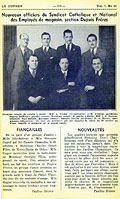 |
|
| |
 Members
of the union executive, 1942-1943. Women were poorly represented on the
executive and did not play an important role until the mid-1940s. Le
Duprex 7(11): 173. Members
of the union executive, 1942-1943. Women were poorly represented on the
executive and did not play an important role until the mid-1940s. Le
Duprex 7(11): 173.
|
|
| |
|
|
|
Although women accounted for almost two-thirds of the company's
workforce,
their influence does not seem to have been reflected in the union's
demands.
For example, pay equity did not make it onto the agenda before 1950. Yet,
it
was no secret that men sometimes earned twice as much as women. In
addition,
women did not rise to senior positions until a few years later. This
situation
can be explained by the poor representation of women on the union
executive and
their subordinate roles. The union, it seems, did not take into
consideration
the needs of its female members. This interpretation is suggested by the
fact
that few women participated in union meetings. To remedy this situation,
the
union offered cash door prizes and even tried to attract young saleswomen
by
introducing a dowry fund, which, however, never materialized.
| |
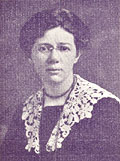 |
|
| |
 Églantine
Phaneuf, president of the Association professionnelle des employées
de
magasin, a women's organization, 1927. Le Duprex 13(6): 8. Églantine
Phaneuf, president of the Association professionnelle des employées
de
magasin, a women's organization, 1927. Le Duprex 13(6): 8.
|
|
| |
|
|
|
To correct this lack of consideration for women, the Association
professionnelle
des employées de magasin was established in 1906 as an alternative
for
women working in retail. Founded and run by Églantine Phaneuf, the
association
helped young female workers prepare for their mission within the family
and society.
Its monthly meetings offered courses in language, tailoring, sewing,
embroidery,
and cooking. Although the Association permitted women to express their
needs
more openly than they could in the union, it perpetuated the traditional
roles
women were expected to play and it did not defend women's
fundamental rights
as workers.
|
Repercussions of the Second World War
Following the Second World War, the union's structure underwent
major
changes. The role of women changed radically. A greater number of women
rose
to strategic positions on the executive and were promoted. As a result,
they
had more influence within the company and the union. This was the direct
result
of the war, which had liberated women to work in the primary and secondary
sectors
of the labour market. From that time on, women played active roles in the
building
of society and they came to occupy the positions they deserved. Their
demands
within Quebec society were inevitably reflected within the union.
As the number of strikes skyrocketed, the Church had to rethink and
adapt
its policies. Its social doctrine evolved, making strikes a possibility
-
at least under certain conditions - as a pressure tactic. These
conditions
had to be approved by the bishop. The cause had to be just and reasonable;
all
other means of resolving the issue (reconciliation and arbitration) had to
be
exhausted; workers had to continue to show respect for employers and their
property;
and, the strike had to have a chance of success. The Church, which until
then
had given employers its unconditional support by advocating strict
obedience
to established authority, did an about-face by siding with the workers,
causing
quite a stir among the Dupuis Frères executives, who had close ties
to
the religious communities.
Conclusion
Eventually, the Dupuis employees came to realize that their union was
only
symbolic in nature, since it did not protect them from mass layoffs. They
decided
to create an autonomous union that would defend their interests and
extricate
them from the intellectual bosom of management paternalism where they had
been
held for so long. The 1952 strike led to a rupture with clerical
paternalism
and gave the union its freedom.
Further Reading
Collectif Clio. Quebec Women: A History, edited by Micheline
Dumont.
Toronto: Women's Press, 1987.
Dionne, Bernard. Le syndicalisme au Québec.
Montréal:
Boréal, 1991.
Linteau, Paul-André, René Durocher and Jean-Claude
Robert. Quebec:
A History, 2 vols. Toronto: James Lorimer, 1983.
Rouillard, Jacques. Histoire du syndicalisme
québécois:
Des origines à nos jours. Montréal: Boréal,
1989.
|
|